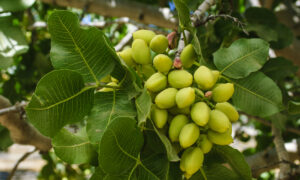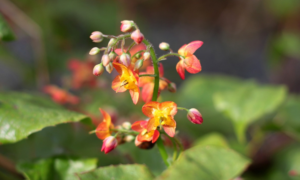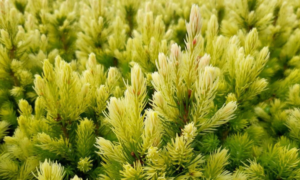We independently research, review, and recommend the best products. If you buy something through our links, we may earn a commission. Learn more.
Interested in livening up your patio or porch with a fruit tree? Sweet! It may surprise you to learn that there are several vibrant fruit trees that thrive here in the U.K. — many of which are easy to grow from seed.
Imagine an arching bough replete with ripening figs, or a fragrant dwarf pomegranate tree with coppery-red leaves. You could completely transform any small outdoor space in a few simple steps.
But before picking out the perfect planter, it’s important to first choose a fruit tree that fits your climate, space, and skill level. In this article, we’ll discuss some great fruit tree options for patios and porches, offering expert tips on how to maintain them.
Contents
How to choose a fruit tree
One of the most important things to consider when selecting a fruit tree is the rootstock—the base and root portion of grafted plants. It’s essential to choose a rootstock that is well suited to container growing and performs in your climate and soil conditions. Many specialist suppliers can provide you with this information and help you select the right rootstock.
When it comes to pollination, it’s important to check with suppliers to see if you need more than one tree to ensure good pollination. Some fruit trees, such as apricots, are self-fertile, so you will get fruit with only one tree. Other trees, such as apples and pears, require a partner nearby for pollination.
Dwarf Citrus Trees
Dwarf citrus trees, such as lemon, lime, orange, and grapefruit, are perfect for patios as they only grow to around 6-8 feet tall. However, as citrus fruit isn’t hardy in Britain, you’ll want to bring any outdoor pots inside when there’s a cold snap. At other times of the year, you should place them in a spot that gets at least 6 hours of direct sunlight per day.
Many gardeners opt for lemons or kumquats as they’re the best citrus fruits for battling cold weather. If you want to grow limes or grapefruits, however, you’ll need the mercury to rise by several degrees.
To ensure a bountiful harvest, it’s important to thin out fruit as it grows, to allow for adequate sunlight and airflow. Dwarf citrus trees are also prone to pests like mealybugs and scale insects, so keep an eye out for any signs of infestation. They are grafted on trifoliata rootstock which is known for its cold hardiness, disease resistance, and vigour, but you should fertilise the soil monthly during the growing season for the best chances of success.
Dwarf Apple Trees

Dwarf apple trees are a great option for those with limited space, as they are typically grown in a container or espaliered against a wall.
One of the best options for patios is the Greensleeves apple tree. This variety is grafted on the M27 rootstock which makes it a naturally miniature tree that looks like a perfect scaled-down orchard. Surprisingly, it can produce heavy crops (up to 30 lbs per tree) when fully established and yields early in life, often from the first season.
Dwarf apple trees require full sun and well-draining soil. You should also fertilise every 4-6 weeks during the growing season with a balanced mix.
Proper pruning is essential for maintaining the health and productivity of your apple tree. Prune your tree in the winter while it’s dormant—this will encourage proper shaping and fruit production. Additionally, thin out the fruit as it grows, to allow for adequate sunlight and airflow.
Dwarf Fig Trees
If you love the taste of figs but don’t have enough space for a large tree, the dwarf variety could be your answer. This low-maintenance fruit tree looks similar to a bonsai and produces figs in a container. The ideal temperature for growth is between 16C-24C, so Britain offers the ideal climate during warmer months.
You should position your fig tree in bright but indirect light for the best results. Aim to do this by placing the container next to a window that is partially blocked with either other plants or decor.
Dwarf fig trees are drought tolerant, but it is essential to water them consistently during the fruiting season. They are grafted on ficus carica rootstock, which is known for its drought tolerance and disease resistance.
Dwarf Peach Trees

Peach trees can produce their namesake fruit in a small, confined space. So they’re perfect for porches and patios!
Peaches need lots of sunlight to produce bountiful yields and stave off disease. Therefore, we recommend keeping your tree next to a south-west facing wall or fence, preferably sheltered by glass in cooler weather. Just be mindful that your tree may need to be hand-pollinated in shady spots.
In addition to using well-drained soil, you can top-dress the base generously with rotted organic matter in spring, adding a well-balanced organic fertiliser every 4-6 weeks. We also advise using mulch mixed with sawdust or wood chips. Avoid heavy soils.
Dwarf Peach trees are grafted on Lovell rootstock, which is known for its cold hardiness, disease resistance and dwarfing, but you’ll need to prune hard in late winter.
Dwarf Cherry Trees
Do you have a sunny spot with decent air circulation? If the answer is yes, you should consider buying a dwarf cherry tree. These stunning landscape plants are grafted on Mahaleb rootstock, which is known for its dwarfing, disease resistance, and hardiness.
To care for a dwarf cherry tree, use mulch made from well-rotted organic matter and a balanced fertiliser — this is crucial in spring. You should also grow sweet cherries with at least one other flowering tree at the same time for pollination. Pruning takes place in late winter.
The main difficulty is protecting your dwarf cherry tree from bird damage — as our flying friends love this fruit. Therefore, we recommend using netting or a scarecrow to keep your plant intact. In warmer climates, these trees can develop fungal diseases, but because they tend to ripen early, they’re easier to maintain than other varieties.






